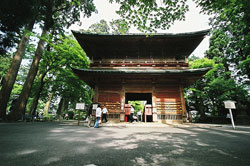Enryaku-ji on Mount Hiei, a wooded mountain northeast of Kyoto, was established in 788 by Saicho (who introduced the Tendai sect to Japan). It has been one of the most significant monasteries in Japanese history. It is the headquarters of the Tendai sect, the Buddhist sect that served as foundation for a number of later evolving sects including the Pure Land (Jodo), Zen and Nichiren sects.

History
Enryaku-ji Temple was founded at the request of the Emperor Kammu, as a station to guard to newly-founded capital of Heian-kyo (Kyoto) against evil spirits that were held to approach from the northeast. From its modest beginnings, Enryaku-ji Temple grew to become the headquarters of the Tendai school of Buddhism, and at its peak the complex comprised over 3,000 subtemples and had a population of several thousand monks.
Enryaku-ji has educated numerous great priests who founded important Buddhist sects, including Honen, Shinran, Eisai, Dogen and Nichiren, starting in the Heian Period. Most of these leading lights of Japanese Buddhism went on to establish their own sects. On this note, Enryaku-ji temple is considered a key site of Japanese intellectual and religious history.
It was also strongly involved in the nation’s politics, and had its own army. This proved to be Enryaku-ji’s undoing, however, and in 1571 the warlord Oda Nobunaga invaded Enryaku-ji Temple, burning much of it to the ground and leaving few survivors. The temple recovered slowly, and is now only a shadow of its former self. Yet it still possesses its aura of power, devotion and impenetrable mystery.
What to see
Today, most of Enryaku-ji's attractions are concentrated in three areas: Todo (East area) where Enryakuji was originally founded, Saito (West area) which can be reached from Todo in a pleasant 20 minute walk through the forest, and the more distant and less spectacular Yokawa area.
The temple is still imbued with a solemn atmosphere as a place of training. In the Central Hall (Kompon Chudo) visitors enter a long room where the altars are sunken below the worship floor. Smoke from incense fills the room with a fragrant haze and almost lends a quality of movement to the statues and other items on the altars. Three of the lanterns in this room are said to have remained alight for over 1200 years.
Included within its expansive precincts are other large buildings as the Lecture Hall (Daikodo), Shaka Hall (Shakado) and Yokawachudo. The Lecture Hall and Shaka Hall are both Important Cultural Properties.
Address
4220 Honmachi, Sakamoto, Otsu City, Shiga Prefecture.
Tel: 077-578-0001



